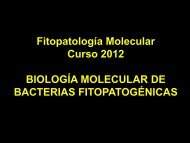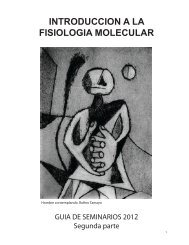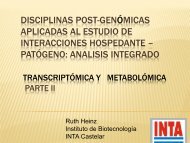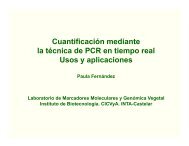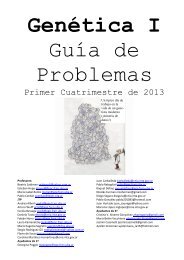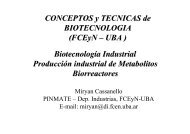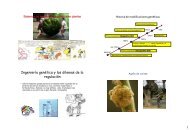Reacción en cadena de la polimerasa (PCR) - FBMC
Reacción en cadena de la polimerasa (PCR) - FBMC
Reacción en cadena de la polimerasa (PCR) - FBMC
Create successful ePaper yourself
Turn your PDF publications into a flip-book with our unique Google optimized e-Paper software.
2) Los alumnos recibirán preparados <strong>de</strong> difer<strong>en</strong>tes especies vegetales (Helianthus y tricepiro [¿no se l<strong>la</strong>ma Triticale?]<br />
híbrido c<strong>en</strong>t<strong>en</strong>o-trigo) hibridados mediante <strong>la</strong>s técnicas <strong>de</strong> FISH y GISH y los observarán al microscopio <strong>de</strong> epifluoresc<strong>en</strong>cia<br />
(Leica DMLB). (Nota: <strong>la</strong> preparación <strong>de</strong> los portaobjetos con los preparados cromosómicos es simi<strong>la</strong>r a <strong>la</strong><br />
ya vista <strong>en</strong> los TPs <strong>de</strong> G<strong>en</strong>ética I y otras materias y el proceso <strong>de</strong> hibridación <strong>de</strong> <strong>la</strong>s sondas será sólo explicada porque<br />
no se difer<strong>en</strong>cia conceptualm<strong>en</strong>te <strong>de</strong> otras hibridaciones tipo Southern blot también muy conocidas).<br />
Refer<strong>en</strong>cias Bibliográficas<br />
Ambros, P.F., Matzke, M.A. and Matzke, A.J.M. (1986) Detection of a 17-kb unique sequ<strong>en</strong>ce (T-DNA) in p<strong>la</strong>nt chromosomes by in situ hybridization.<br />
EMBO J. 5: 2073–2077.<br />
B<strong>en</strong>ab<strong>de</strong>lmouna, A., Gueritaine, G., Abirached-Darm<strong>en</strong>cy, M. and Darm<strong>en</strong>cy, H. (2003) G<strong>en</strong>ome discrimination in prog<strong>en</strong>y of interspecific<br />
hybrids betwe<strong>en</strong> Brassica napus and Raphanus raphanistrum. G<strong>en</strong>ome 46: 469-472.<br />
B<strong>en</strong>nett, M.D. (1995) The <strong>de</strong>velopm<strong>en</strong>t and use of g<strong>en</strong>omic in situ hybridization (GISH) as a new tool in p<strong>la</strong>nt biosystematics. Bransham PE,<br />
B<strong>en</strong>nett MD (eds) Kew Chromosome Confer<strong>en</strong>ce IV, Royal Botanical Gard<strong>en</strong>s, Kew, UK: 167-183.<br />
Carlson, A.R., Letarte, J., Ch<strong>en</strong>, J. and Kasha, K.J. (2001) Visual scre<strong>en</strong>ing of microspore-<strong>de</strong>rived transg<strong>en</strong>ic barley (Hor<strong>de</strong>um vulgare L.) with<br />
gre<strong>en</strong>-fluoresc<strong>en</strong>t protein. P<strong>la</strong>nt Cell Rep 20: 331–337.<br />
Ch<strong>en</strong>g, Z., Presting, G., Robin Buell, C., Wing, R.A. and Jiang, J. (2001) High-Resolution Pachyt<strong>en</strong>e Chromosome Mapping of Bacterial Artificial<br />
Chromosomes Anchored by G<strong>en</strong>etic Markers Reveals the C<strong>en</strong>tromere Location and the Distribution of G<strong>en</strong>etic Recombination Al ong Chromosome<br />
10 of Rice. G<strong>en</strong>etics 157: 1749-1757.<br />
Jackson, S., Wang, M.L., Goodman, H.M. and Jiang, J. (1998) Application of fiber-FISH in physical mapping of Arabidopsis thaliana. G<strong>en</strong>ome<br />
41: 566-557.<br />
Jiang, J. and Gill, B.S. (1994) Nonisotopic in situ hybridization and p<strong>la</strong>nt g<strong>en</strong>ome mapping: the first 10 years. G<strong>en</strong>ome 37: 717-725.<br />
Hoop<strong>en</strong>, R.T., Robbins, T.P., Fransz, P.F., Montijn, B.M., Oud, O., Gerats, A.G.M. and Nanningga, N. (1996) Localization of T-DNA insertions in<br />
Petunia by fluoresc<strong>en</strong>ce in situ hybridization: physical evid<strong>en</strong>ce for suppression of recombination. P<strong>la</strong>nt Cell 8: 823-830.<br />
Lapitan, N.L.V., Brown, S.E., K<strong>en</strong>nard, W., Steph<strong>en</strong>s, J.L. and Knudson, D.L. (1997) FISH physical mapping with barley BAC clones. P<strong>la</strong>nt J.<br />
11: 149–156.<br />
Moscone, E.A., Matzke, M.A. and Matzke, A.J.M. (1996) The use of combined FISH/GISH in conjunction with DAPI counterstaining to id<strong>en</strong>tify<br />
chromosomes containing transg<strong>en</strong>e inserts in amphidiploid tobacco. Chromosoma 105: 231-236.<br />
Mouras, A. and Negrutiu, I. (1989) Localization of the T-DNA on marker chromosomes in transfomed tobacco cells by in situ hybridization.<br />
Theor Appl G<strong>en</strong>et 78: 715–720.<br />
Mouras, A., Saul, M.W., Essad, S. and Potrykus, I. (1987) Localization by in situ hybridization of a low copy chimaeric resistance g<strong>en</strong>e introduced<br />
into p<strong>la</strong>nts by direct g<strong>en</strong>e transfer. Mol G<strong>en</strong> G<strong>en</strong>et 207: 204-209.<br />
Pe<strong>de</strong>rs<strong>en</strong>, C., Zimny, J., Becker, D., Jahne-Gartner and Lorz, H. (1997) Localization of introduced g<strong>en</strong>es on the chromosomes of transg<strong>en</strong>ic<br />
barley, wheat and triticale by fluoresc<strong>en</strong>ce in situ hybridization. Theor Appl G<strong>en</strong>et 94: 749–757.<br />
Poggio, L., Confalonieri, V., Comas, C., Gonzalez and Naranjo, C. (1999) G<strong>en</strong>omics affinities of Zea luxurians, Z. diplopernnis and Z. per<strong>en</strong>nies:<br />
meiotic behavior of their hybrids and g<strong>en</strong>omic "in situ" hybridization (GISH). G<strong>en</strong>ome 42: 993-1000.<br />
Salvo-Garrido, H., Travell, S., Schwarzacher, T., Harwood, W.A. and Snape, J.W. (2001) An effici<strong>en</strong>t method for physical mapping of<br />
transg<strong>en</strong>es in barley using in situ hybridization. G<strong>en</strong>ome 44: 104–110.<br />
Shigyo, M., Wako, T., Kojima, A., Yamauchi, N. and Tashiro, Y. (2003) Transmission of ali<strong>en</strong> chromosomes from selfed prog<strong>en</strong>ies of a complete<br />
set of Allium monosomic additions: the <strong>de</strong>velopm<strong>en</strong>t of a reliable method for the maint<strong>en</strong>ance of a monosomic addition set. G<strong>en</strong>ome 46: 1098-<br />
1103.<br />
Wang, C.J. and Ch<strong>en</strong>, C.C. (2005) Cytog<strong>en</strong>etic mapping in maize. Cytog<strong>en</strong>et G<strong>en</strong>ome Resh<strong>en</strong>.<br />
Wei, W.H., Zhao, W.P., Song, Y.C., Liu, L.H., Guo, L.Q. and Gu, M.G. (2003) G<strong>en</strong>omic in situ hybridization analysis for id<strong>en</strong>tification of introgressed<br />
segm<strong>en</strong>ts in allop<strong>la</strong>smic lines from Zea mays × Zea diploper<strong>en</strong>nis. Hereditas 138: 21-26.<br />
TP 7: Filogeografía y su aplicación al control <strong>de</strong> p<strong>la</strong>gas: un ejemplo <strong>en</strong> el insecto p<strong>la</strong>ga <strong>de</strong>l algodón Anthonomus<br />
grandis (“picudo <strong>de</strong>l algodonero”)<br />
Los métodos filogeográficos constituy<strong>en</strong> <strong>en</strong> una valiosa herrami<strong>en</strong>ta para el control <strong>de</strong> p<strong>la</strong>gas, ya que permit<strong>en</strong><br />
establecer el lugar <strong>de</strong> orig<strong>en</strong> <strong>de</strong> <strong>la</strong>s pob<strong>la</strong>ciones invasoras, el grado <strong>de</strong> ais<strong>la</strong>mi<strong>en</strong>to <strong>en</strong>tre el<strong>la</strong>s y los procesos<br />
históricos que tuvieron lugar durante su evolución <strong>en</strong> el tiempo y el espacio (Confalonieri et al., 1998, 2002;<br />
Lanteri, 1999; Scataglini et al., 2000; Lanteri & Confalonieri, 2003). El “picudo <strong>de</strong>l algodonero”, Anthonomus grandis,<br />
es <strong>la</strong> p<strong>la</strong>ga con mayor impacto sobre el cultivo <strong>de</strong> algodón <strong>en</strong> el contin<strong>en</strong>te Americano. Los daños ocasionados<br />
por su pres<strong>en</strong>cia fueron <strong>de</strong>tectados ya <strong>de</strong>s<strong>de</strong> inicios <strong>de</strong>l siglo XX <strong>en</strong> el cinturón algodonero <strong>de</strong>l sur <strong>de</strong><br />
Estados Unidos, y su ingreso <strong>en</strong> Brasil <strong>en</strong> el año 1983 tuvo como consecu<strong>en</strong>cia <strong>la</strong> infección <strong>de</strong> un 90% <strong>de</strong> los<br />
cultivos <strong>de</strong> algodón <strong>de</strong>l país.<br />
En los años posteriores, el insecto continuó<br />
expandiéndose hacia Paraguay (1991), Arg<strong>en</strong>tina<br />
(1993) y Bolivia (1997) colonizando tanto<br />
áreas cultivadas como no-cultivadas (Lanteri et<br />
al., 2003).<br />
Según <strong>la</strong> hipótesis <strong>de</strong> Burke et al. (1986) <strong>la</strong><br />
llegada <strong>de</strong>l picudo a Estados Unidos habría<br />
t<strong>en</strong>ido lugar <strong>en</strong> el Pleistoc<strong>en</strong>o y se explicaría<br />
por una dispersión natural <strong>de</strong>s<strong>de</strong> <strong>la</strong>s selvas <strong>de</strong>l<br />
sur <strong>de</strong> México a través <strong>de</strong> una serie <strong>de</strong> p<strong>la</strong>ntas<br />
nativas <strong>de</strong> <strong>la</strong> familia <strong>de</strong> <strong>la</strong>s Malváceas. Por<br />
su parte, <strong>la</strong> pres<strong>en</strong>cia <strong>de</strong> A. grandis <strong>en</strong> distintos<br />
países <strong>de</strong> América <strong>de</strong>l Sur ha sido consi<strong>de</strong>rada<br />
un f<strong>en</strong>óm<strong>en</strong>o reci<strong>en</strong>te como resultado<br />
<strong>de</strong> introducciones sucesivas a causa <strong>de</strong>l comercio<br />
<strong>de</strong>l algodón (Manessi, 1997). La secu<strong>en</strong>cia<br />
temporal <strong>de</strong> <strong>la</strong>s apariciones registradas<br />
llevó a proponer que los picudos <strong>de</strong> Brasil ha-<br />
Página 14 <strong>de</strong> 40



